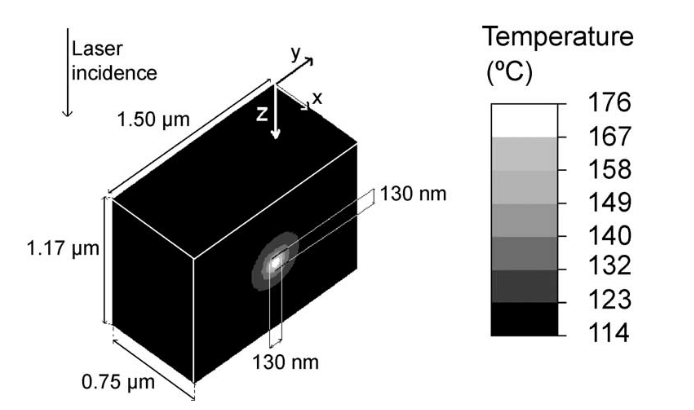Abstract The mesostructure and composition of composite materials determine their mechanical, optical and thermal properties and, consequently, their response to incident radiation. We have developed general finite element models of porous composite materials under infrared radiation to examine the influence of pore size on one of the determining parameters of the stress distribution in the material: the temperature distribution. We apply them to the specific case of human dental enamel, a material which has nanometer scale pores containing water/organic, and predict the maximum temperature reached after a single 0.35 m s laser pulse of sub-ablative fluence by two lasers: Er:YAG (2.9 m m) and CO 2 (10.6 m m). For the Er:YAG laser, the results imply a strong dependence of the maximum temperature reached at the pore on the area-to-volume ratio of the pore, whereas there is little such dependence for CO 2 lasers. Thus, CO 2 lasers may produce more reproducible results than Er:YAG lasers when it comes to enamel ablation, which may be of significant interest during clinical practice. More generally, when ablating composite materials by infrared lasers researchers should account for the material’s microstructure and composition when designing experiments or interpreting results, since a more simplistic continuum approach may not be sufficient to explain differences observed during ablation of materials with similar optical properties or of the same material but using different wavelengths.
Keywords: Dental Laser; Laser ablation; Finite element modelling; Mesoscopic modelling; Er:YAG laser; CO 2 laser
1. Introduction The mesoscopic structure and composition of a material can play a significant role in the mechanisms of laser ablation, since it determines the mechanical, thermal and optical properties of materials [1,2] . Yet, relatively few theoretical or computational models account for this explicitly. The development of better ablation models should allow more realistic predic- tions of the influence of different laser parameters on ablation which will play a key role in optimizing ablation. We have developed general models to study the thermal and mechanical response of porous com- posite materials under infrared radiation. Here, we describe an application of these models to human dental enamel.Currently, the ablation of dental enamel in the context of caries treatment uses Er:YAG (l¼2.9mm) and CO2(l¼10.6mm) lasers among others, but is subject to problems such as relatively low ablation rates or, when higher ablation rates are wanted, the possibility of cracking and unwanted thermal effects. If laser treatments are to become common practice, the procedures must be optimized to yield higher ablation rates while minimizing unwanted side-effects and, in the framework of minimally invasive dentistry, also ensure that precise, narrow tunnels can be drilled in teeth.
1.1. Model description Human dental enamel is composed mainly of HA. It is known that enamel is porous to an extent, and that the pores contain mainly water, but also a small amount of organic material; the exact proportion of water/organic, the pore size and area distributions, and pore connectivity are not known [6] . Based on this information the authors developed six fi nite element models for enamel (using Algor TM Version 13.14-WIN 15-FEB-2002), each representing a piece of HA surrounding a single cubic water-pore, and used them to obtain temperature maps caused by the absorption of a sub-ablative laser pulse. The six models differ only on the size of the pore. The length of pore edges, l , varies between 30 and 130 nm (see Fig. 1 ). With each model we performed transient heat transfer simulations of a single 0.35 m s laser pulse for laser radiation of l ¼ 2.9 and 10.6 m m, using 28 timesteps of 0.0125 m s duration. We used 26,195 8-node brick elements with second order Gaussian quadrature formulation. The mesh was made sign- i fi cantly denser at the pore than in the zones surround- ing it.

Conclusions Given the variability of the composition and mesos- tructure of enamel, in particular in pore size, and knowing that the thermal stress generated by laser radiation is directly related to the temperature reached, our simulations suggest that the results of ablating enamel using Er:YAG lasers may be harder to predict and reproduce from sample to sample than using CO 2 lasers. Researchers conducting experiments with these lasers, and even other IR wavelengths, may consider appropriate to select their samples attending to factors that could cause marked differences in water content, such as age or region in the tooth (see also ref. [11] ). Researchers conducting in vitro experiments should also pay attention to possible differences that could arise from using hydrated or dehydrated teeth, and also teeth that were dehydrated and subsequently rehy- drated. More generally, these results suggest that one of the parameters governing ablation — the tempera- ture — may be, for certain combinations of lasers and material properties, strongly dependent of the material ’ s pore size and area distribution. These results suggest that in order to accurately interpret information resulting from ablation of composite materials, the material ’ s mesostructure and compo- sition should be considered. Researchers ablating composite materials may want to consider these material characteristics when selecting samples or analysing results.

